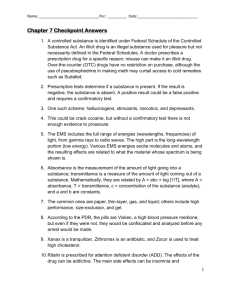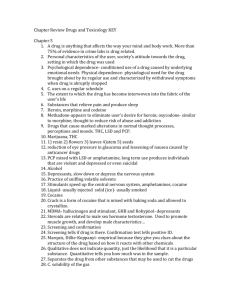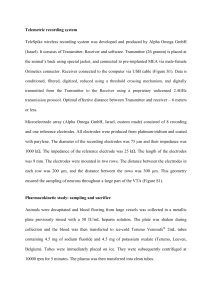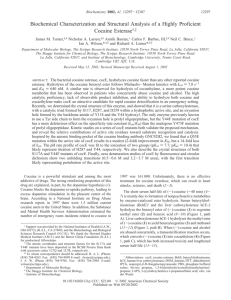A Therapy for Cocaine Toxicity
advertisement
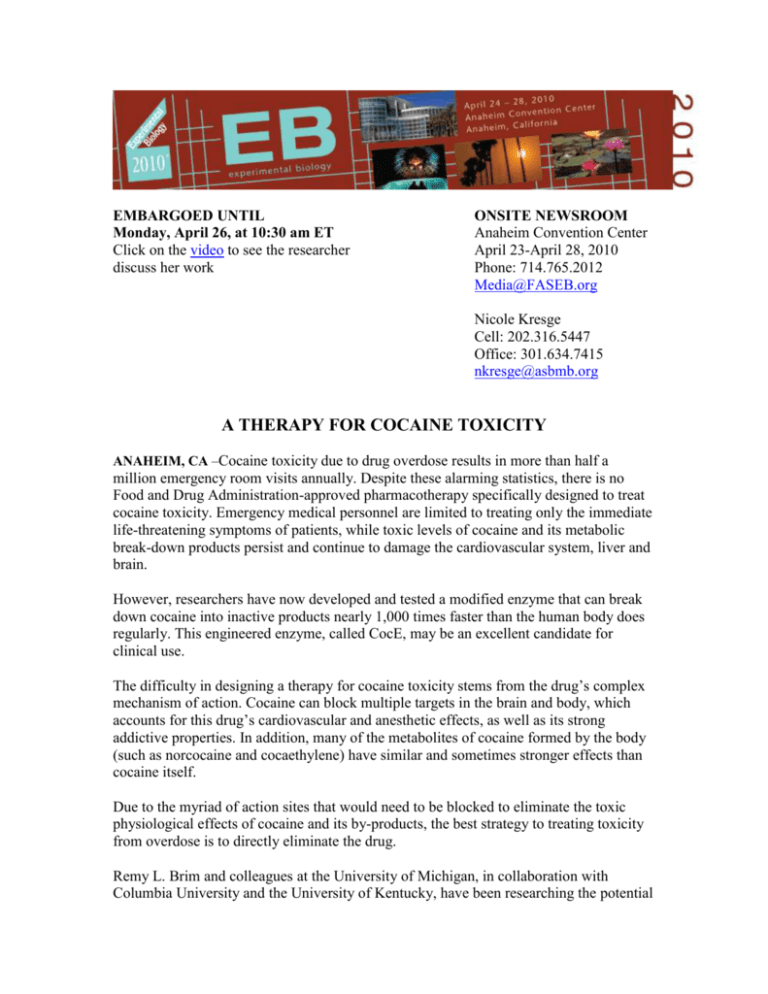
EMBARGOED UNTIL Monday, April 26, at 10:30 am ET Click on the video to see the researcher discuss her work ONSITE NEWSROOM Anaheim Convention Center April 23-April 28, 2010 Phone: 714.765.2012 Media@FASEB.org Nicole Kresge Cell: 202.316.5447 Office: 301.634.7415 nkresge@asbmb.org A THERAPY FOR COCAINE TOXICITY ANAHEIM, CA –Cocaine toxicity due to drug overdose results in more than half a million emergency room visits annually. Despite these alarming statistics, there is no Food and Drug Administration-approved pharmacotherapy specifically designed to treat cocaine toxicity. Emergency medical personnel are limited to treating only the immediate life-threatening symptoms of patients, while toxic levels of cocaine and its metabolic break-down products persist and continue to damage the cardiovascular system, liver and brain. However, researchers have now developed and tested a modified enzyme that can break down cocaine into inactive products nearly 1,000 times faster than the human body does regularly. This engineered enzyme, called CocE, may be an excellent candidate for clinical use. The difficulty in designing a therapy for cocaine toxicity stems from the drug’s complex mechanism of action. Cocaine can block multiple targets in the brain and body, which accounts for this drug’s cardiovascular and anesthetic effects, as well as its strong addictive properties. In addition, many of the metabolites of cocaine formed by the body (such as norcocaine and cocaethylene) have similar and sometimes stronger effects than cocaine itself. Due to the myriad of action sites that would need to be blocked to eliminate the toxic physiological effects of cocaine and its by-products, the best strategy to treating toxicity from overdose is to directly eliminate the drug. Remy L. Brim and colleagues at the University of Michigan, in collaboration with Columbia University and the University of Kentucky, have been researching the potential of cocaine esterase (CocE) to block cocaine toxicity by eliminating cocaine. CocE is an enzyme originally isolated from a soil bacterium found around the roots of the coca plant, that can break down cocaine into the same metabolites as the natural human enzyme butyrylcholinesterase, only much more rapidly. CocE, however, is naturally unstable at the normal body temperature of 37°C. To enhance the thermal stability of the enzyme, the investigators used a series of biochemical and computational approaches to modify the enzyme. The thermally stable CocE was found to effectively degrade cocaine and two of cocaine’s active metabolites, norcocaine and cocaethylene, and not degrade benzoylecgonine, the metabolite used in urinalyses for recent cocaine use. The researchers also evaluated CocE’s ability to break down cocaine in the presence of drugs commonly co-abused with cocaine, and observed no reduction in CocE’s action in the presence of alcohol, nicotine, and morphine, among others. These promising results, in combination with previous studies that show CocE can reverse cocaine-induced cardiovascular changes, seizures, convulsions and lethality in rodent models, suggest that CocE may be a good candidate for clinical treatment of cocaine toxicity. Brim will present this research, which was supported by the National Institutes of Health, the National Institute of Drug Abuse, and Reckitt Benckiser, at the American Society for Pharmacology and Experimental Therapeutics annual meeting in a poster titled “Ability of bacterial cocaine esterase to hydrolyze active cocaine metabolites, and function in the presence of commonly co-abused drugs.” The presentation will occur on Monday, April 26, at 12:30 pm PST in Exhibit Hall CD of the Anaheim Convention Center. ### NOTE TO EDITORS: The American Society for Pharmacology and Experimental Therapeutics annual meeting is part of the Experimental Biology 2010 conference that will be held April 24-28, 2010 at the Anaheim Convention Center. The press is invited to attend or to make an appointment to interview Ms. Brim. Please contact Nicole Kresge at 202.316.5447 or nkresge@asbmb.org. ASPET (www.aspet.org) is a 4,800 member scientific society whose members conduct basic and clinical pharmacological research in academia, industry and the government. Its members’ research efforts help develop new medicines and therapeutic agents to fight existing and emerging diseases.

